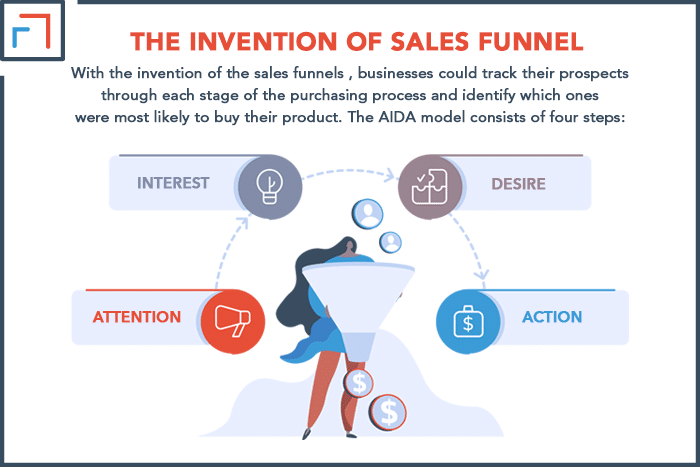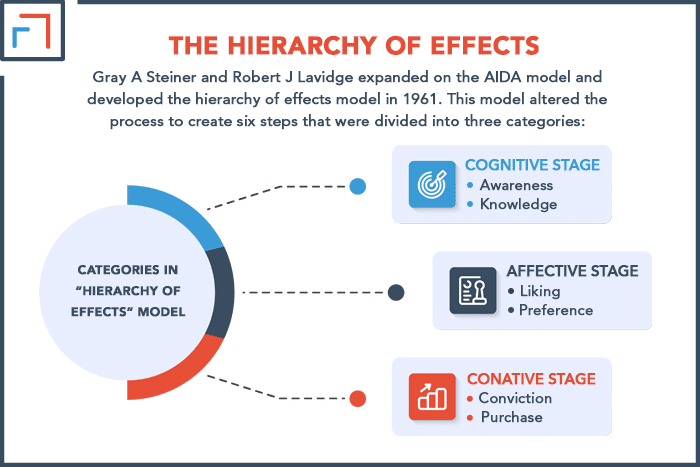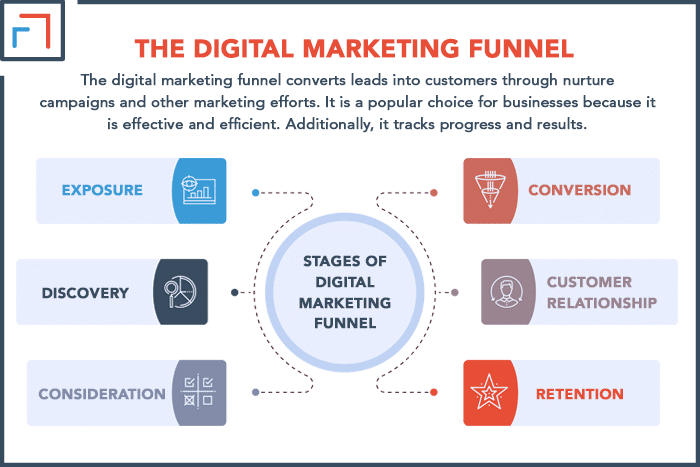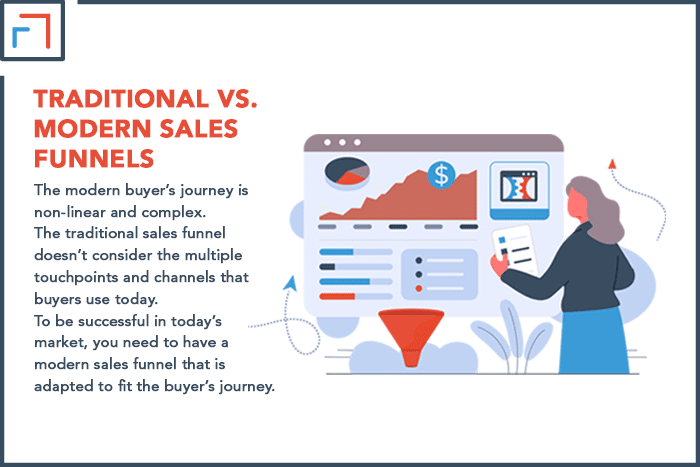Digital sales funnels have taken the 21st Century by storm. No business is complete without one, but where did they come from? How did they evolve into the sales tools we use today? Let’s take a look at the origin of the sales funnel.
The first sales funnel was created in 1898 by E St Elmo Lewis. He designed the AIDA model, which stands for Attention, Interest, Desire, and Action. This model was designed to help salespeople guide their prospects through the purchasing process, and it was incredibly successful.
Now that you know a bit of the sales funnel’s history let’s look at the era before the invention and how they’ve evolved. Marketing principles have remained fairly consistent throughout the years, but we now apply them in different ways.
Pre-sales Funnels Period
Before the invention of sales funnels, barter trade and trade shows were the primary selling methods.
Businesses would set up booths at trade shows and try to attract as much attention as possible.
While this method was effective, it was very inefficient. There was no way to track which potential customers were interested in your product and which were not.
This made it difficult to follow up with interested prospects and close sales.
The Invention of Sales Funnel
The invention of the sales funnels changed all that.
Businesses could now track their prospects through each stage of the purchasing process and identify which ones were most likely to buy their product.
This allowed businesses to focus resources on potential customers, resulting in more sales and a more efficient use of time.
When Lewis came up with the sales funnel process, it was called the AIDA model.
The model has undergone some changes and has become more sophisticated with time.
The AIDA model consists of four steps:
- Attention
- Interest
- Desire
- Action
In 1924, William Townsend proposed the association of the AIDA model with a funnel.
The idea was that potential customers go through these stages as they move from being unaware of a product to becoming its customers/advocates.
1. Attention Stage
The first stage of the sales funnel is the attention stage. This is when a prospect becomes aware of your product or service.
To generate attention, you need to create awareness through marketing and advertising.
The attention stage is the most important stage of the sales funnel because if a prospect is not aware of your product, they will never buy it.
Therefore, it is essential to invest heavily in marketing and advertising in the early stages of your business.
Nowadays, businesses can use various digital marketing techniques to generate attention.
But in the early 1900s, they had to rely on more traditional methods like print ads, TV commercials, and radio ads.
2. Interest
If a prospect is interested in your product or service, they will move to the next sales funnel stage: interest.
Today, you can generate interest by providing more information about your product or service.
This can be done through content marketing, such as blog posts, eBooks, and infographics.
You can also generate interest by offering free trials or demos of your product. This allows prospects to experience your product and see if it is a good fit for their needs.
But imagine a world without the internet!
Traditionally, businesses would generate interest by sending salespeople to meet with prospects and giving them more information about the product.
While this method is still common today, it is not as effective as it was.
Most people don’t appreciate an interruption by salespeople when they are trying to research a product or service.
3. Desire
The desire stage is when a prospect starts to want your product or service.
To generate desire, you need to show potential customers how your product or service will meet their needs.
You can do this through case studies, testimonials, and success stories. These show prospects how your product or service has helped others in a similar situation.
You can also generate desire by offering discounts and special offers to make your product or service more attractive to undecided buyers.
In the early days of the sales funnel, businesses would generate desire by sending out direct mailings and cold-calling potential customers.
The modern-day spam emails and telemarketing calls are the direct descendants of these early marketing techniques.
They are usually not very effective because people reject the concept of a hard sell. Promotions and discounts are a better strategy to use.
4. Action
The final stage of the sales funnel is action. This is where a prospect buys your product or service.
To generate action, you need to make it easy for prospects to purchase your product or service.
You can do this by having a well-designed website and a simple checkout process.
You can also generate action by offering financing or payment plans. You should make it easier to purchase your product or service.
The age of the internet has made it easier than ever to generate action.
In the early days of the sales funnel, businesses had to rely on more traditional methods, which took time to relay information.
They also needed physical storefronts that customers could visit.
Today, you can use digital marketing techniques like search engine optimization and social media marketing to generate action.

The Hierarchy of Effects
In the 20th Century, the AIDA process gained popularity as the “hierarchy of effects” model.
Gray A Steiner and Robert J Lavidge expanded on the AIDA model and developed the hierarchy of effects model in 1961.
This model altered the process to create six steps that were divided into three categories:
- Cognitive
- Affective
- Conative
1. Cognitive Stage
The stage has two steps:
- Awareness: In this stage, the potential customer becomes aware of the product or service. You should communicate the desirable features of your product.
- Knowledge: Customers learn about the features and benefits of the product or service. They go to reviews, social media, and your website to learn more about your product. The research helps them develop a need for your product.
2. Affective Stage
In this segment, the customer likes and prefers your product or service. The affective stage has two steps:
- Liking: The buyer starts to like your product or service. Rarely will customers like your product right away. You need to establish trust and confidence in your product before they like it. You can accomplish this through testimonials and social proof.
- Preference: After comparing you with competitors, the customer decides that your product is the best option.
Liking is not the same as preference. The customer may like your product but choose a different seller.
Therefore, it is essential to establish your product as the best option through marketing and advertising.
3. Conative Stage
Finally, the potential customer intends to buy your product or service. The conative stage has two steps:
- Conviction: Unlike the previous stage, in conviction, the client is confident that your product or service will meet their needs. They are ready to buy but need some push. This is where you offer a guarantee or maybe a promise of free shipping.
- Purchase: Finally, the goal of the sales funnel has been achieved, and the client buys your product or service. After the purchase, you enter the customer into your loyalty program to keep them coming back for more.
The model shows that the sales funnel has changed and evolved. What was once a simple process has become a sophisticated system that helps businesses close more sales.

Modern-day Versions of Sales Funnels
Now that we’ve looked at the history and evolution of sales funnels let’s look at some modern-day versions.
In the early 2010s, HubSpot popularized the term “inbound marketing.”
Inbound marketing generates leads through content marketing, social media, and search engine optimization.
The inbound method is an updated way to generate leads and has become increasingly popular among businesses.
Sales funnels were popularized, and companies launched tools, such as ClickFunnels and LeadPages, to help businesses create and automate their sales funnels.
| Sales Funnel Tool | When It Was Created |
|---|---|
| ClickFunnels | 2014 |
| LeadPages | 2012 |
| SamCart | 2014 |
| Kartra | 2018 |
| Kajabi | 2010 |
| Unbounce | 2009 |
| Systeme.io | 2018 |
Today, there are different variations of the model. One of the most common is the digital marketing funnel.
The Digital Marketing Funnel
This sales funnel uses digital marketing techniques to generate leads and close sales. It focuses on generating leads through online channels.
These channels include content marketing, search engine optimization, and social media.
The digital marketing funnel converts leads into customers through nurture campaigns and other marketing efforts.
The digital marketing funnel is a popular choice for businesses because it is effective and efficient. Additionally, it tracks progress and results.
Unlike traditional funnels, digital marketing funnels have a broad top and bottom. The model has six stages:
- Exposure
- Discovery
- Consideration
- Conversion
- Customer Relationship
- Retention
1. Exposure
Inbound marketing starts with exposure, which is when a potential customer becomes aware of your brand.
There are several ways to generate exposure, such as:
- Search engine optimization
- Social media
- Affiliates
- Forums
- Blogs
- Content marketing
The objective of this stage is to get your brand in front of as many people as possible.
Instead of broadcasting the message to the customer, inbound marketing allows the customers to find you.
Therefore, it is important to have a strong online presence and create content that is shareable and SEO-friendly.
Having a unique and recognizable brand will also help you stand out because customers buy solutions, not products.
2. Discovery
If you have put your message in front of the right people, they will take notice and want to learn more about your brand.
This is the discovery stage, where potential customers seek solutions to their problems.
It is essential to provide potential customers with the information they are looking for at this stage. You can do this through:
- Landing pages
- Website copy
- Blog posts
- Case studies
- White papers
You should educate potential customers about your brand and try to build trust.
You want to position yourself as an expert in your industry and show potential customers that you can provide the solution they are looking for.
3. Consideration
How far the customer progresses down your sales funnel depends on your product’s ability to meet their needs.
If you have been able to provide potential customers with the information they need, they will enter the consideration stage.
At this stage, potential customers are evaluating your brand and comparing you to other options.
This is where having a strong online presence is essential because you want to be at the top when potential customers are ready to make a purchase.
Some things you can do to stay top of mind are:
- Sending targeted ads
- Sending email newsletters
- Staying active on social media
- Publishing blog posts
This stage aims to keep your brand in front of potential customers and make it easy for them to find you when they are ready to buy.
4. Conversion
When potential customers are ready to commit, they will enter the conversion stage.
This is when you want to make it seamless to purchase your product or service. You can do this by:
- Creating a strong call-to-action
- Offering a discount
- Making the purchase process easy
You should work to remove any barriers that would prevent potential customers from buying your product/service.
Ensure that you have a simple checkout process and that your website is secure.
Also, be accessible and responsive so potential customers can reach you if they have any questions.
5. Customer Relationship
You’ll want to nurture customer relationships so you can turn one-time buyers into lifelong customers.
After closing the deal, you should provide an exceptional customer experience. You can do this by:
- Asking for feedback
- Sending thank-you notes
- Offering discounts or coupons for future purchases
- Staying in touch
The goal is to keep your customers happy and engaged so they will continue doing business with you.
6. Retention
Customer retention is when customers continue to do business with you after the initial purchase. If you want to achieve this, you should:
- Offer excellent customer service
- Build a strong brand
- Create a loyalty program
The key is to have as many people as possible promoting your brand. Remember, closing a sale doesn’t mean your relationship with a customer is over.
In fact, it’s just the beginning. Apart from the digital marketing funnel, there are other models that propose a narrow top and bottom sales funnel.
The model suggests that you should target a specific audience for each product. After that, you create a pool of potential clients in the middle of the funnel.

Traditional Vs. Modern Sales Funnels
| Traditional Sales Funnels | Modern Sales Funnel |
|---|---|
| Linear | Dynamic |
| One-dimensional | Complex |
| Physical touchpoints | Physical & digital touchpoints |
| One model | Variations of the original model |
| Created for traditional channels | Designed to fit different channels |
The sales funnel has changed a lot over the years. In the past, the sales process was linear and one-dimensional.
The modern buyer’s journey is non-linear and complex. The traditional sales funnel doesn’t consider the multiple touchpoints and channels that buyers use today.
With help from the internet, potential customers can research your competitors and purchase without speaking to a salesperson.
If you want to be successful in today’s market, you need to have a modern sales funnel that is adapted to fit the buyer’s journey.

Key Takeaway
The invention of the sales funnel was a crucial development in marketing history. Although it has evolved, the basic premise remains the same.
The goal is to take potential customers through a journey from awareness to purchase.
If you want to be successful in sales, you need to understand how the sales funnel works and how you can use it to your advantage.
You should also be aware of the different stages of the sales funnel and what you should do at each stage to nurture your potential customers and close the deal.
